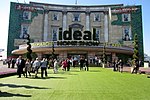Earl's Court tube station

Earl's Court tube station is a Grade II listed London Underground station in Earl's Court, London, on the District and Piccadilly lines. It is an important interchange for both lines and is situated in both Travelcard Zone 1 and Zone 2. The station has an eastern entrance on Earl's Court Road and a western entrance on Warwick Road (both part of A3220). Another former entrance allowed passengers to enter the station from the other side of Warwick Road, via a ticket hall and subway leading to a concourse beneath the District line platforms. Earl's Court is a step-free tube station; the Earls Court Road entrance provides lift access between street and platform levels. The station was opened by the District Railway in 1871, two years after the line was built, and had become a hub to five different local routes by 1874. It was damaged by fire the following year, and a new station was constructed on the other side of Earl's Court Road, opening in 1878. A connection to the Great Northern, Piccadilly and Brompton Railway (now the Piccadilly Line) opened in 1906. Earl's Court was the first tube station with escalators, which were added in 1911. Major redevelopment and rebuilding work occurred in 1915, 1936–37 and 2005.
Excerpt from the Wikipedia article Earl's Court tube station (License: CC BY-SA 3.0, Authors, Images).Earl's Court tube station
Old Manor Yard, London Earl's Court (Royal Borough of Kensington and Chelsea)
Geographical coordinates (GPS) Address Nearby Places Show on map
Geographical coordinates (GPS)
| Latitude | Longitude |
|---|---|
| N 51.4913 ° | E -0.1947 ° |
Address
5
Old Manor Yard
SW5 9AB London, Earl's Court (Royal Borough of Kensington and Chelsea)
England, United Kingdom
Open on Google Maps









